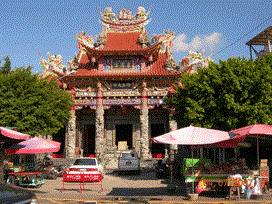1. Tian Fu Temple
Time of building: in Yongli year of the Ming Dynasty Consecrate Figure: Zhong-tan-yuan-shuai The temple is
grand and solemn. The shrine is made by the Chinese juniper. Detail outlines of the temple are carved on the
camphor wood. The noticeable stone pillar with nine dragons in front of the shrine is 6 m high and its diameter is
1 m, which carving comes out on top in Taiwan.
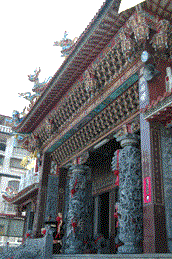
2. Ci-mi-tang
Time of building: 1899 Consecrate Figure: Martial Sage Guangong It was rebuilt to 3-floor superb palace style architecture with rich oriental colors in 1973. Before the hall, the Chun and Ciou Pavilions built in 1951 stand erect in the pool. The carved beams and painted rafters are gorgeous and resplendent.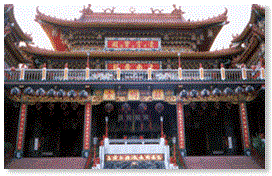
3.Cing Shuei Temple
Time of building: before the Sino-Japanese War Consecrate Figure: Founder Cing Shuei It combines characteristics of Chinese and Western architecture. The statue of Founder Cing Shuei which is 15 m high, 9 m long, and 8 m wide is assembled with 387 units of hong-long stones. The statue is placed on the top of the 5th floor. The Ceramic Dragons and Phoenixes Palace on the 5th floor is magnificent and brilliant. The ceramic ware here is made meticulously. The 6 m high Chinese unicorn stove in front of the temple and stone carvings inside the temple are all made by qing-dou stones. They are assembled by master workers from Putian and Quanzhou in Fujian province, China.
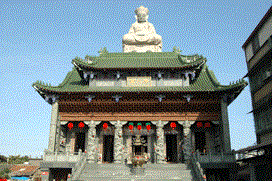
4. Yuan Di Temple
Time of building: in Yongli year of the Ming Dynasty Consecrate Figure: Monarch Syuantian In 1991, the Beiji Pavilion was built in the middle of Lianchihtan. There are 18 holy guards standing along the arch bridge. The holy statue of Monarch Syuantian is the highest statue in Southeast Asia. The treasured sword he holds weighs 1380 kg. It is worthy to be the No. 1 sword around the world.
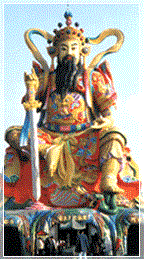

5. Old Town Cheng Huang Temple
In 1718 (the 57th year ruled by Emperor Kangsi) , the magistrate Lee Pi-Yu made a donation of his salary to buid this temple. There are many historical relics made during Qianlong and Jiaqing of the Qing Dynasty stored in the temple. They have rich historical value. Walls of this temple are shorter than general temples and are surrounded strange atmospheres. There are statues with ugly faces, outmoded instruments of torture, boards inscribed with threatened terms, and a big abacus. It seems like that soul of dead people is sent to the Cheng Huang Temple to accept trial.
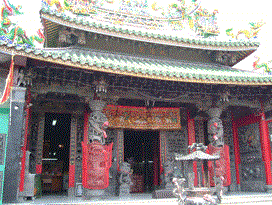
6. Ciji Temple
Time of building: 1960 Consecrate Figure: Taoist Wu Taoist Wu was originally known as Wu Ben. In the 11th century, he was born in Tongan county in Cyuanzhou. He was good at medical skills, generous to people, as well as pure and with few desires. After he died, residents built the temple and consecrated his statue. The emperor granted the board carved with “Ciji” to this temple, and then successive emperors conferred him as “Zhongxian”, “Ying-hui-hou”, and so on. Since then Ciji Temples have been all over Changzhou and Quanzhou. Taiwan was a place with malaria in the past, and the Zheng clan and related officers are all from Zhangzhou and Cyuanzhou. Therefore, many people had beliefs and temples were built earlier. According to “Record of Fengshan County ” in 1719, the Ciji Temple was located to the north of Xinglong Village. In 1960, people with great respect rebuilt the Ciji Temple at No. 9, Liantan. The temple consecrated Baoshen Emporer (Bao-sheng-da-di) as the tutelary god for residents.
